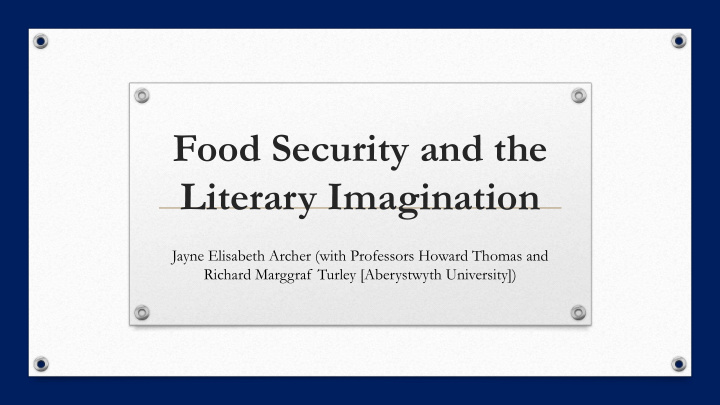



Food Security and the Literary Imagination Jayne Elisabeth Archer (with Professors Howard Thomas and Richard Marggraf Turley [Aberystwyth University])
Charles Dickens (1812-70) • Oliver Twist (1837-38) • ‘Please, sir, I want some more’ • Three servings of ‘thin gruel a day, with an onion twice a week, and half a roll on Sundays’ • Jonathan Swift, A Modest Proposal (1729)
A Christmas Carol (1843) Too much, or not enough?
Food riots in Dickens’ novels • A Tale of Two Cities (1859) • Barnaby Rudge (1841) • Set during the French Revolution • Set during the Gordon Riots (1789) (London, June 1780) • Includes the storming of the Bastille • Set amid the American War of and alludes to the beginnings of the Independence (1765-1783) Terror • Describes the liberation and prisoners from London prisons, including Newgate
Food and the Literary Imagination Chaucer Shakespeare Keats George Eliot
‘Good and Bad Fungus’ • Published in Dickens’ periodical All the Year Round , 6 August 1859 • Followed an instalment of A Tale of Two Cities , ‘Still Knitting’ • Describes the effect of consuming food contaminated with a variety of toxins, including ergot of rye, mildew and fungi
‘A diseased state of rye and other grasses, called ergot, is owing to a fungus which causes the ovary of the grain to become dark coloured, and project from the chaff in the form of a spur; and hence its name of spurred rye. The nutritious part of the grain is destroyed, and it acquires highly injurious properties .’ The fungus called ‘ racodium ’ is said to be attracted to casks of wine, and another fungus , ‘ Agaricus muscarius ’, is used ‘in decoction, as an intoxicating liquor ’: ‘when they drink it they are seized with convulsions in all their limbs, followed by that sort of raving which accompanies a burning fever’.
‘In the close and stifling atmosphere of the vault … the floors were of sodden earth, the walls and roof of damp bare brick tapestried with the trails of snails and slugs; the air was sickening, tainted, and offensive . It seemed, from one strong flavour which was uppermost among the various odours of the place, that it had, at no very distant period, been used as a storehouse for cheeses ; a circumstance which, while it accounted for the greasy moisture that hung about it, was agreeably suggestive of rats. It was naturally damp besides, and little trees of fungus sprung from every mouldering corner .’ [ Charles Dickens, Barnaby Rudge (1841), ed. and intr. John Bowen (Penguin Books, 2003), p. 71]
The Gordon Riots as Food Riot • The professed objective is to compel Parliament to repeal recent, pro- Catholic legislation, but ‘under the noisy revel of the public -house, there lurked unseen and dangerous matter’ (p. 328) • The rioters anticipate ‘an altered state of society’ (p. 331) • ‘The mob raged and roared, like a mad monster’ (p. 408) • The rioters gather in St George’s Fields and march north, crossing the Thames, to storm Westminster, the public prisons (including Newgate) and key strategic sites of civic and national governance
The Mob as Deadly Harvest • ‘Mr Dennis [the hangman] might Blue Cockade = corncockle • have been likened to a farmer The execution of rioters: ‘Such was the • ruminating among his crops, and enjoying by anticipation the bountiful ntiful wholesome growth of the seed sown by gifts of Provide denc nce. Look where he the law, that this kind of harvest was would, some heap of ruins afforded usually looked for, as a matter of him rich promise of a working off; course.’ (p. 636) the whole town ap appear ared to hav ave been ploughed hed, an and sown, n, an and Hugh’s dying curse against his father: • nurtur rtured ed by most genial al weather; her; ‘On that black tree, of which I am the and an a goodly g ly har arvest st was as at han and .’ ripened fruit, I do invoke the curse of all (p. 582) its victims, past, present, and to come.’ (p, 646)
The Fiery Lake • ‘The gutters of the street and every crack and fissure in the stones, ran with scorching spirit ; which, being dammed up by busy hands, overflowed the road and pavement; and formed a great pool, in which the people dropped down dead by dozens. They lay in heaps all round the fearful pond … and drank until they died … others sprang up from the fiery draught, and danced, half in mad triumph, and half in the agony of suffocation, until they fell, and steeped their corpses in the liquor that had killed them . Nor was this even the worst or most appalling kind of death that happened on this fatal night …’ (p. 569)
History as Haunting • A Tal ale of Two Cities (1859 59) • Revisits its man any moti tifs, fs, includi uding ng the mob devouring ing a l lak ake of wine; the execut ution oner as as reap aper; contamina ntaminated ted food suppl ply; y; dan ancing ng mad adness ness an and frenzied self- destruct truction on • The citizen ens of St Antoine oine ar are suffe feri ring ng from ergotism sm (blac ack grai ains)
Some Thoughts • The role of the food riot in driving political and social change; it is predictable and unpredictable • The role of medicine (including history of medicine) and plant science in informing literary analysis • The need to respect knowledge and practices acquired through experience • The demented and dying
Recommend
More recommend